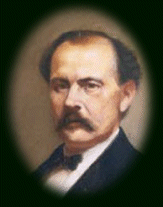 |
a railroad built |

|
 |
a railroad built |

|
Odenton, Maryland was named for Oden Bowie (1826 - 1894), the President of the Baltimore and Potomac Railroad and 37th Governor of Maryland (1869 - 1872). The town was established in 1873 in a very rural area of northwestern Anne Arundel County at the junction of the Annapolis and Elk Ridge Railroad and the new Baltimore and Potomac Railroad line.
The B&P Railroad, which passed through Odenton, began as an effort to connect Baltimore with southern Maryland. At the same time, the Pennsylvania Railroad wanted to build a line from Baltimore to Wahsington; however, a federal law prohibited any railroad other than the Baltimore and Ohio from entering the city directly. The B&P's charter had a provision by which lateral spurs not exceeding 20 miles in length could be built; the Pennsylvania knew of this provision and in 1870 arranged to buy half of the B&P stock - after agreeing to build the B&P into southern Maryland. The Pennsy built the lines through Bowie (then callled Huntington City) to Pope's Creek, thence into Wahsington via a legal "spur". On November 1, 1902 the B&P - including the tracks through Odenton - officially became part of the Pennsy.
From its inception until the early 20th century, Odenton was a sleepy agricultural area in central Maryland, little more than a post office and a train station surrounded by tomato farms. However, the outbreak of World War I brought an unexepcted boon to the area and Odenton, as it is today, was born.
When the war broke out the United States government wanted to establish a training camp for soldiers. Through some fast talking the management of the Washington, Baltimore and Annapolis Railroad convinced the government to lease almost 20,000 acres of land (controlled by the railroad) along the railroad's right-of-way near Odenton, between the road's crossing with the Pennsylvania Railroad at Odenton and its junction with the Baltimore and Ohio at Annapolis Junction, between Jessups and Savage. Thus Camp Meade - named for Civil War General George Gordon Meade - was established; Fort George G. Meade remains active today, still occupying the land acquired from the WB&A.
Approximately one half mile southeast of the junction with the Pennsy the WB&A crossed its own Baltimore-Washington line at a point called Naval Academy Junction (just west of the present-day intersection of Maryland routes 170 and 175). The Junction had a station, a restaurant and the road's car repair shops. With the end of World War I and the rapidly growing popularity of the automobile, activity on the WB&A slacked considerably and - with steadily-falling ridership and the onset of the Great Depression - the railroad finally succombed and went into recievership in 1935, throwing Odenton into a mini-depression of its own.
Once again, a war broke out and in 1943 the Winer family moved their cabinetmaking business from Baltimore to the abandoned WB&A car shops on Route 170. Known then as National Plastics, the company - an innovator in plastic laminate surfaces - became Nevamar; throughout its history, the plant was a customer of the freight railroads that plied the tracks through Odenton, with a spur from just beneath the MD 175 overpass to the factory. As of this writing (August 8, 2005) this spur is still in place and in occasional use by Norfolk Southern.
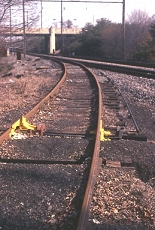 Just west of the aforementioned spur, which ran to the south off the rightmost track when
facing east (toward Baltimore), was another spur which connected the Pennsylvania to the
Baltimore and Ohio at Annapolis Junction. The section of track which ran through Fort Meade
was a remnant of the failed WB&A, and ran on the roadbed originally surveyed in 1848 to form
part of the Annapolis and Elk Ridge Railroad.
Just west of the aforementioned spur, which ran to the south off the rightmost track when
facing east (toward Baltimore), was another spur which connected the Pennsylvania to the
Baltimore and Ohio at Annapolis Junction. The section of track which ran through Fort Meade
was a remnant of the failed WB&A, and ran on the roadbed originally surveyed in 1848 to form
part of the Annapolis and Elk Ridge Railroad.
This spur, leading to the compass west (railroad south) from the leftmost track when facing Baltimore, was active and served the needs of Fort Meade well into the 1970s, though at the very end Fort Meade was used as a storage depot for the concrete ties which were being laid by AMTRAK on the Northeast Corridor and the spur merely allowed access to the ties. Consolodated Rail Corporation (Conrail - which was the freight equivalent of AMTRAK) owned the spur between Odenton and Fort Meade; it applied on November 30, 1981 to abandon the 1.6 mile line between milepost 0.0 (Odenton) and milepost 1.6 (Fort Mead [sic])1; when the portion of the project for which ties were being stored at Fort Meade was completed the trains, after nearly 140 years, left - and they pulled up the rails behind them:
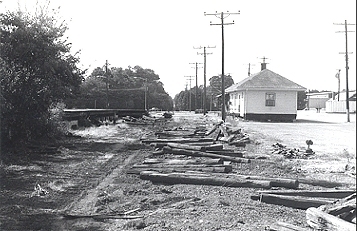 |
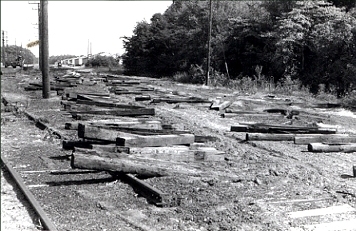 |
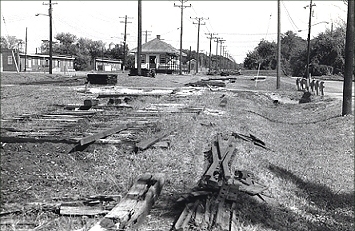 |
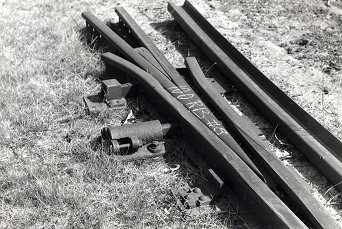 |
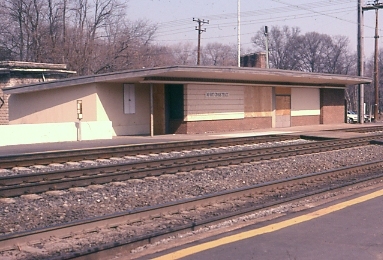
|
Odneton remained a stop on the Pennsylvania and the Penn Central, but when Amtrak was born
the station was closed, the building becoming a m.o.w. storehouse.
In the 1990s, the Maryland Transit Administration division of the Maryland Department of Transaportation purchased the Odenton station and its associated property from AMTRAK, along with multiple parcels of land from private property owners around the station. Around 2005 more property was acquired and the North parking lot was built. The East parking lot (the lot on the opposite side of the tracks from the station is under a rental agreement wit Anne Arundel County. There are plans for further development of the MARC property at Odenton, which include construction of a parking garae on the present West parking lot; there is, however, no timetable for that development.
|
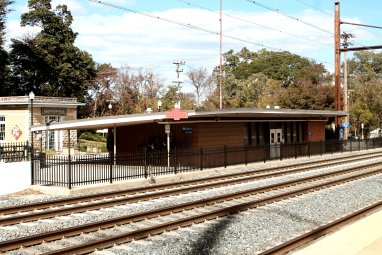
|
For a short time (literally) the Pennsylvania operated trains - or at least intended to - to Bowie race track, about 6 1⁄2 miles from Odenton. On March 18, 19362, the Philadelphia, Baltimore and Washington Railroad Company and the Pennsylvanua Railroad Company, lessee, applied to the ICC to acquire and oeprate 6.4 miles of railroad track between Odenton and the race track, which railroad track was formerly owned by the Washington, Baltimore and Annapolis Electric Railway Company (which went into receivership in 1935). The petition was approved; however, either the project never saw fruition or it was a failure, because a mere 7 months later, on October 3, 19363, the company filed for abandonment of the same trackage.
1Hagley Library (Greenvulle, NJ), Conrail railroad abandonment index,
United States Interstate Commerce Commission railroad
abandonment index,
Index cards to Conrail finance dockets, 1975/1984,
Accession number AVD.ICC.2014.001, Hagley ID: Conrail
2Hagley Library (Greenvulle, NJ), Pennsylvania Railroad (PRR) abandonment index Part 1,
United States Interstate Commerce Commission railroad abandonment index,
Index cards to PRR finance dockets, 1920/1946, 11133, 3/18/36,
Accession number AVD.ICC.2014.001, Hagley ID: Pennsylvania_Pt1
3Hagley Library (Greenvulle, NJ), Pennsylvania Railroad (PRR) abandonment index Part 1,
United States Interstate Commerce Commission railroad abandonment index,
Index cards to PRR finance dockets, 1920/1946, 11373, 10/3/36,
Accession number AVD.ICC.2014.001, Hagley ID: Pennsylvania_Pt1